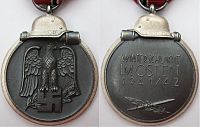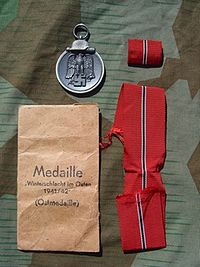- Eastern Front Medal
-
Eastern Front Medal
Die Medaille Winterschlacht Im Osten 1941/42 (Ostmedaille)
The medal's obverse (left) and reverse (right).Awarded by Nazi Germany Type Chest order Eligibility Military personnel Awarded for Awarded to all German military personnel who participated in the first winter of Operation Barbarossa (the invasion of the Soviet Union). Campaign World War II Statistics Established May 26, 1942 Last awarded September 4, 1944 Total awarded over 3 000 000 
Ostmedaille ribbon barThe Eastern Front Medal, (Winterschlacht Im Osten), more commonly known as the Ostmedaille was instituted on May 26, 1942 to mark service on the German Eastern Front (World War II) during the period November 15, 1941 to April 15, 1942. It was commissioned to recognise the hardship endured by German and Axis Powers personnel, combatant or non-combatant, during the especially bitter Russian winter of '41/'42. It was wryly called the "Gefrierfleischorden" (Frozen Meat Medal) by the Heer, Luftwaffe & Waffen-SS personnel to whom it was awarded. [1]
Qualification for the award
- 14 days served in active combat within the specified area between November 15, 1941 – April 15, 1942
- 60 days served in specified area between November 15, 1941 – April 15, 1942, non-combat
- Wounded in action
- Killed in action (posthumous award)
- Injury caused by frostbite (or another injury related to the climate) severe enough to warrant the issue of a Wound Badge
Unique in that its designer was a contemporary serving soldier, SS-Unterscharführer Ernst Krause, the medal was held in high regard by all branches of the Wehrmacht. Measuring 36mm in diameter, of (generally) zinc construction, the medal was given a gun-metal coloured coating. On one side an eagle grasps a Swastika and the reverse features the text "Winterschlacht Im Osten 1941/42" featuring a crossed sword and branch below the text. The helmet and outer ring were finished in a polished silver effect. A ribbon that accompanied the medal was coloured red, white and black (symbolic of blood, snow and death). The medal and ribbon were usually presented in a paper packet, but these were invariably discarded. Over 3 million were made by more than 26 confirmed firms by the time the order was officially decommissioned by Oberkommando der Wehrmacht on September 4, 1944.
The medal itself was not worn on the combat tunic as per the 1st class Iron Cross & War Merit Cross for example, but worn as a ribbon bar, or as the ribbon alone stitched through the second from top tunic buttonhole as per 2nd Class Iron Cross and War Merit Cross.[2]
References
Categories:- Military awards and decorations of Germany (Wehrmacht)
- Orders, decorations, and medals of Nazi Germany
Wikimedia Foundation. 2010.

